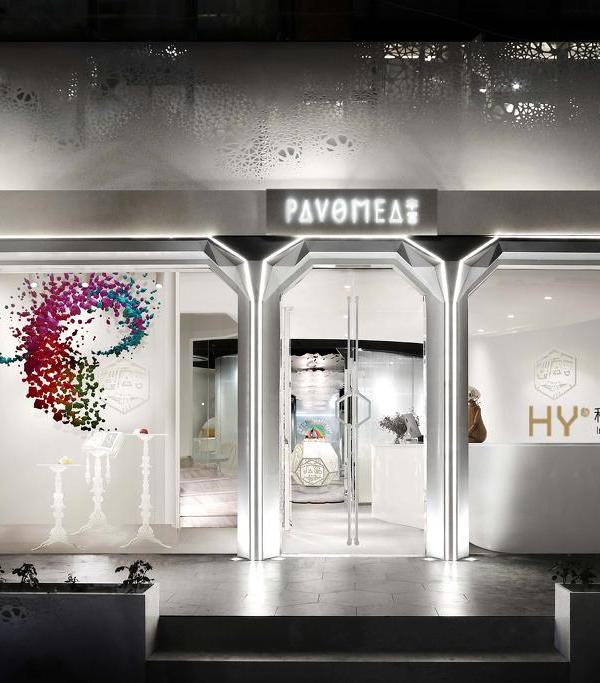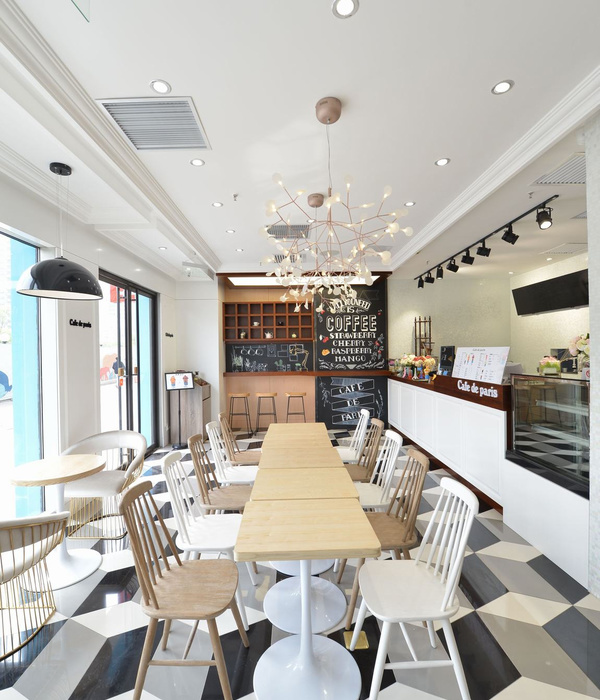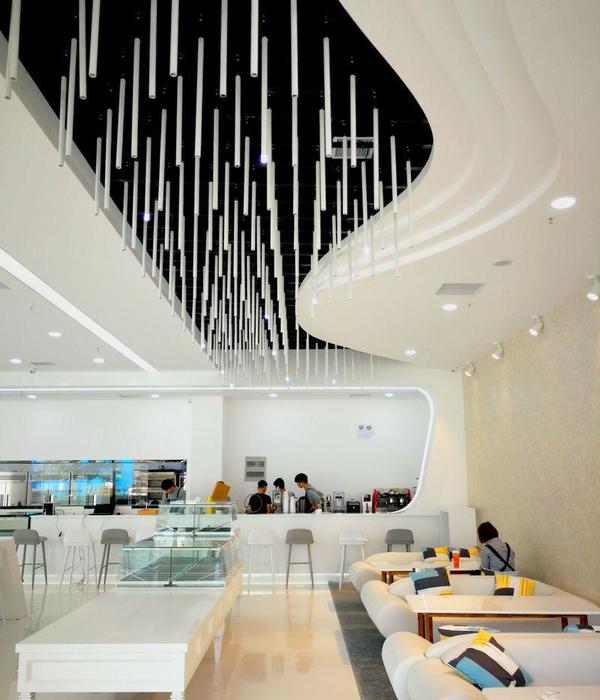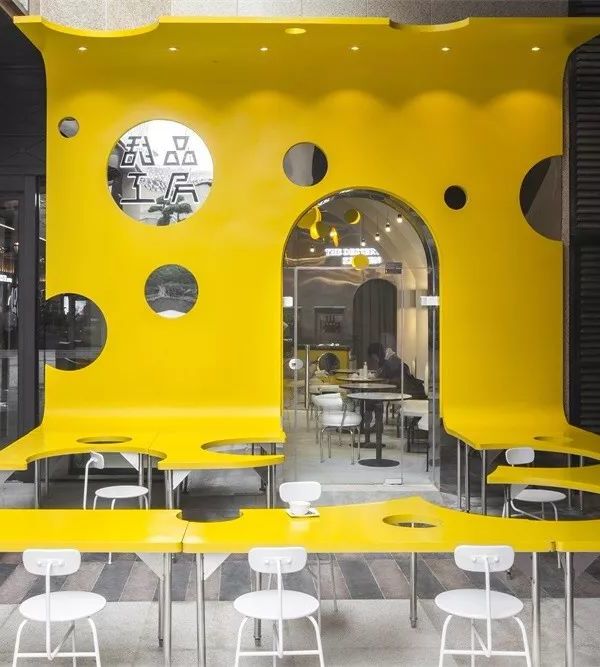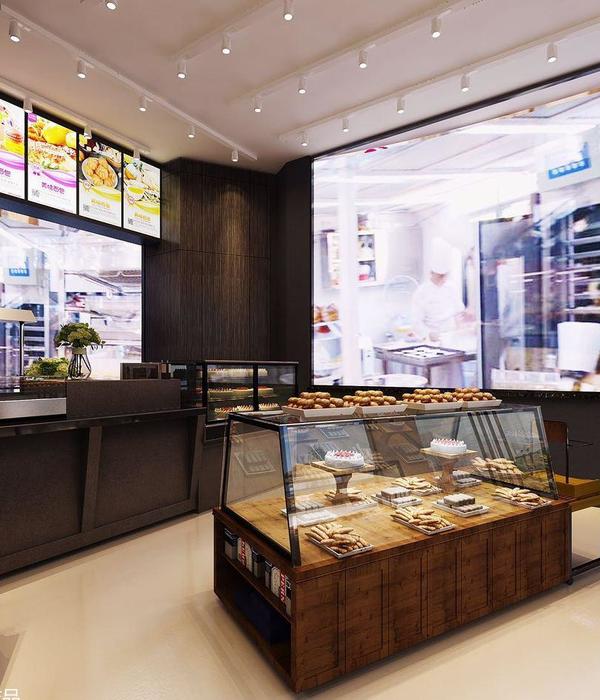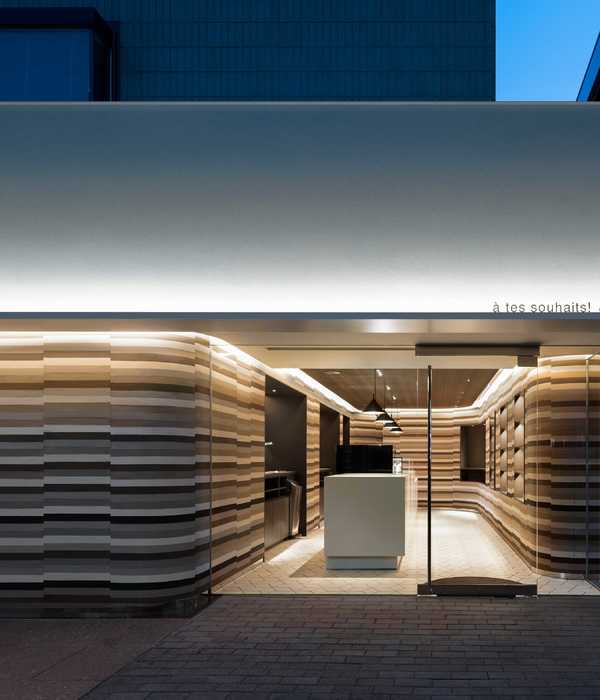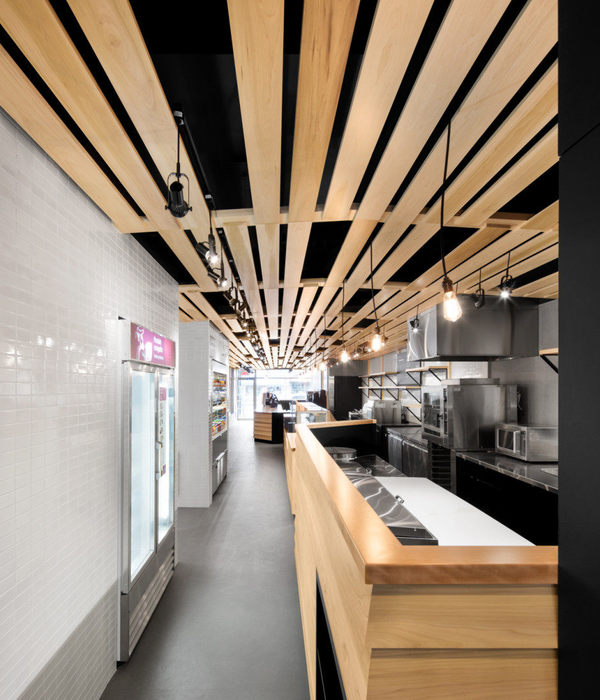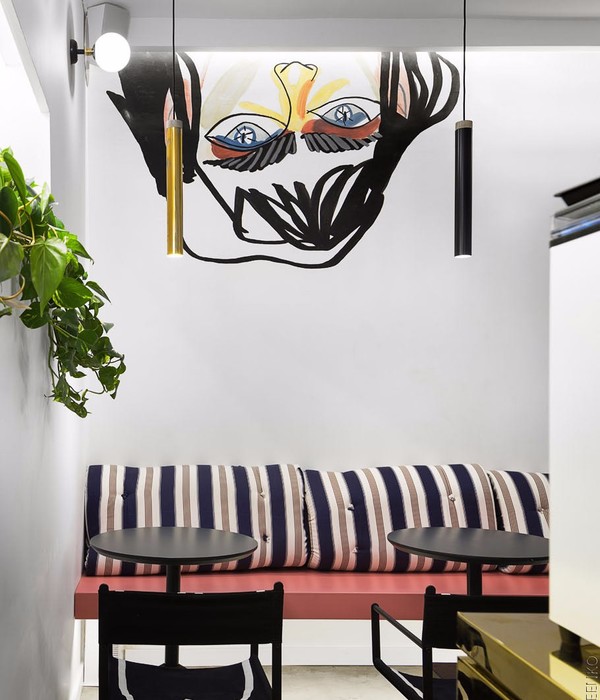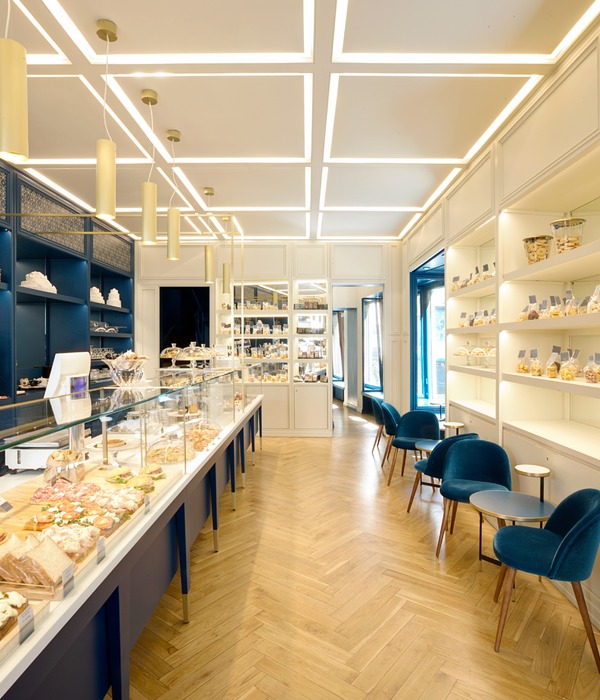取名为“桃源”的村落不胜枚举,足见中国人对于故乡总有对世外桃源的文学幻想:“林尽水源,便得一山”“土地平旷,屋舍俨然”“黄发垂髫,怡然自得”。宀(miǎn)屋位于安徽省祁门县闪里镇的“桃源村”,起源于南宋迁至此处的陈姓家族。先祖“见山秀地美,水口紧扎,深爱之”,村子藏在两山之间的谷地,水口河埠,良田山丘,一应俱全,历经上千年的积淀,形成了典型徽州村落的格局。
The village titled “Taoyuan” is so numerous in China, since Chinese people always have a cultural complex on their hometowns from some fantasy literature, such as “Where the forest ends, where the headwaters is; then the mountain shows”, “The houses are dignified just like the extensive flat land”, “No matter the aged and the young,everyone is slef-satisfied with joy”. The site of the λ house is located at a “Taoyuan” villages in the town called Shanli which in Qimen, Anhui Province. This “Taoyuan Village”, originated a group family surnamed Chen that moved here since the Southern Song Dynasty. The ancestors of this family “see the beauty of the mountains and the waters, deeply loved in this land”. This village hidden in the valley between two mountains, full with water sources and farmland hills, it is a gift land for living and multiply. After thousands of years, the pattern of a typical Huizhou village had been formed.
桃源村鸟瞰图,aerial of Taoyuan Village ©唐徐国
桃源村有上百户,同姓陈,有九个祠堂之多,这在全国都实属罕见,足见桃源村曾富甲一方的盛况。明清时期,徽商纵横全国,在强烈的乡族意识和故土情节影响下,徽商发迹之后回乡兴修祠堂牌坊等公共建筑。而今,由于桃源村相对闭塞,村落的原始格局和徽派建筑的风貌仍然保留完好。其中,散落在村子的不同角落的九个祠堂成为文保建筑,依旧完好如初。
There are hundreds families in Taoyuan village that all surnamed Chen, there are as many as nine ancestral temples which are rarely seen. These temples recorded how flourish and wealthy this village used was in history. During Ming and Qing Dynasties, the merchants from Huizhou were throughout the country, under the influence of strong township consciousness and the nostalgia complex, it was a tradition to construct the ancestral temples and other public buildings when they returned home with fortune . Nowadays, due to the protection of natural environment, the original layout pattern of the village and the Huizhou style architectural appearance are still remain intact. Among them, the nine temples scattered in different location of the village have become the historic preservation buildings that still intact.
▼散落在村子不同角落的祠堂之一,one of the nine temples scattered in different location of the village©唐徐国
安徽祁门县一带因气候条件和经商文化,一直都有制作红茶的传统,并远销外地。而“祁门红茶”成为驰名中外的品牌,起缘于 1915 年桃源村的忠信昌茶号,曾代表祁门红茶参加美国旧金山巴拿马太平洋万国博览会,并荣获民间茶庄金奖。时至今日,桃源村仍然保留家家种茶、制茶、喝茶、售茶的风俗。
Because of climatic conditions and business culture, there is always a tradition of making black tea in the area of Qimen, Anhui Province. The tea is exported to other places and the “Qimen black tea” has become a famous brand both in China and oversea. The historical local business “Cha Chang” that starting from the Taoyuan village in 1915, it used to participate in the Panama Pacific Expo in San Francisco, USA, and won the Gold Award for local tea farm business. Till today, the tradition of plant, product, taste and sale tea are still retains as the family business almost in every family here in Taoyuan village.
当地制茶工序,tea production process
宀屋位于通向村子内部的小路一侧,紧邻叙五祠(古九祠之一)。四周农田环绕,相对独立。房子体量很小,占地只有 60 平米。建筑原状为两层,一层堆放农具,二层由于木屋架高度很低,基本处于空置状态。屋顶为普通穿斗式木构,但已经几近腐朽,墙体则为当地惯常空斗墙做法。
The λ house is located on the side of a path leading to the village, close to Xu Wu Ancestral Temple (one of the nine ancestral temples in ancient China). Surrounded by farmland, relatively independent, the house is very small, covering only 60 square meters. The original structure has two floors, first floor with stacked farm tools and second floor in vacant state due to the low height wooden truss. The roof is an ordinary column-and-tie construction, but has been almost decayed while the wall is made in a local way, hollow bond wall.
▼改造前外观和内部,the exterior and interior before reconstruction
这样一个占地仅有 60 平米的小柴房能做什么用?基于宀屋所处位置的公共性,我们为她设想了两个诉求:一方面,作为祁门红茶的产地,尽管家家户户都有红茶,但村子里尚未有一个专门的红茶体验馆。村里人招待客人,仅是在自家客厅里售卖,缺少品茶、赏茶、论茶的过程。桃源村需要有一个礼仪性的品茶空间。
What can we do in such a woodshed of only 60 square meters? Since the λ house is located in a public area, we envisioned two demands for her: On the one hand, as an origin of Keemun Black Tea, although there is black tea in every household, a special black tea experience museum has not been established in the village. Villagers usually sell tea directly in their living rooms. Since there are no tea tasting, connoisseurship, and appraisal, Taoyuan Village needs a space for tea ceremony shows and tea tasting.
▼当地制茶工坊,local tea workshop
另一方面,桃源村九个祠堂,只有在祭祖节庆等重要时节才被使用。村民平日只能在巷间门口,三五成群地乘凉闲谈。因此我们希望宀屋又是一个为村民开放的,较为轻松和日常的公共场所。于是,宀屋的目标逐渐清晰起来,在一个占地 60 平方的两层农舍里,建造一所兼顾日常性和礼仪性的茶楼。
On the other hand, nine ancestral temples in Taoyuan Village were only used during important festivals such as worships. Villagers can only chat in groups in front of the lane. Therefore, we hope that it is also a more relaxed and daily public place open to villagers. As a result, the function of λ house gradually became clearer: to build a daily and ceremonial teahouse in a two-layer, 60-square-meter farmhouse.
▼宀屋远景,a distant view of λ house©唐徐国
老房子历史悠久,她的气息已经完全得融入这座古村,她的出生和衰老都带着当地时间的印记。如果用先进,现代的技法建造一个新建筑,将无力承托这种时间累积的气质。保留,显然远胜于新造。于是我们原封不动地保留老房子的四个立面,包括粗糙有致的白缝空斗砖墙,包括老木隔栅窗,旧的杉木板门以及徽州民居特有的凸形气窗,而对已经破损的木结构和屋顶进行重建。
The old house has a long history, and her atmosphere has been fully integrated into this ancient village, so that her birth and aging are marked with old times. If we build a new house with advanced and modern techniques, we will be unable to demonstrate this sense of age. A reserved house obviously is far better than a brand new one. So we kept intact the four facades of the old house, including rough hollow bond brick wall with white seam, old wood grilles, old fir door and the convex transom which is typical of Huizhou civil residence. Yet the worn wooden structure and the roof were reconstructed.
▼空斗砖墙肌理,hollow bond brick wall texture
所幸,老房子的屋顶和墙体是彼此独立的承重体系,使得换顶不动墙的方案成为可能。但是空斗砖墙本身结构稳定性比较差,需要加强内部结构来保持稳定。为了保护老墙体在施工过程中不受影响,在拆除内部木结构之前,工人先用钢筋网片加水泥在内墙面多层粉刷,以形成老墙的内部加固层,同时起到施工保护老墙的作用。之后再小心拆除屋顶和木架。
内墙加筋粉刷,interior wall paint and reinforcement
▼立瓦丁字铺,tiles floored in T-word
木架拆除后,我们重新在矩形墙里布置柱网,采用当地最常见的杉木作为梁柱结构。木构一层仍然按照传统的穿斗方式承托楼板,而到了二层承托屋顶的地方,木构采用了一种拟物化的形式语言,用一种俏皮的方式,以树冠的造型将屋顶向外悬挑,来覆盖和保护老墙。
After the wooden frame was removed, we re-arranged the column net in the rectangular wall, using the most common Chinese fir as the beam-column structure. On the first floor, a traditional column-and-tie construction is continued to use to support the floor plate. While on the second floor, employing Skeuomorphism, the wood structure roof is made a smart cantilevered crown-shape to cover and protect the old wall.
▼柱网采用当地最常见的杉木作为梁柱结构,the most common Chinese fir was used as the beam-column structure
▼木构以树冠的造型将屋顶向外悬挑,来覆盖和保护老墙,the wood structure roof is made a smart cantilevered crown-shape to cover and protect the old wall
▼点状烛灯,candlelight dotted
▼结构分解示意,structure explode
最终,建筑一层作为品茶的空间,保留了老房子昏暗内向的氛围。空间的焦点在室内唯一一张深色胡桃木的长茶桌之上。杉木梁柱,横平竖直中正规矩,营造了某种礼仪性。新的杉木柱故意同旧墙窗洞不对位,来暗示这种不明显的新旧关系。
Eventually, the ground floor serves as a space for tea tasting. The dim introverted atmosphere of the old house is retained. The focal point of space indoors lies in an only deep color walnut long tea table. The fir beams and columns, vertical and horizontal normal, creates some kind of ceremonial atmosphere. The new fir column is purposely constructed in front of the old window opening, showing such an unobvious relationship between old and new.
▼建筑一层作为品茶的空间,the ground floor serves as a space for tea tasting©赵奕龙
©唐徐国
©唐徐国
▼新的杉木柱故意同旧墙窗洞不对位,the new fir column is purposely constructed in front of the old window opening©唐徐国
▼结构细部,structure detail
二层空间因屋顶的抬高留出缝隙,空间围合感被彻底改变。新屋顶同老墙之间的空隙使得内与外有了更多的互动:祠堂、田园、山峦的景观从不同的方向涌入内部。有了屋顶的庇护,在二层的公共空间,村民可以从新的视点欣赏村子里熟悉的景观。
Due to the rise of the roof, the second floor is left a gap. Therefore, the sense of confinement is completely changed. The gap between the new roof and the old wall allows for more interaction between the inside and the outside: the ancestral halls, idyllic and mountainous landscapes flow in different directions. With the roof as shelter, in the second floor public space, villagers can enjoy the familiar view of whole village from a new deck.
二层空间因屋顶的抬高留出缝隙,the second floor is left a gap due to the rise of the roof©赵奕龙
▼祠堂、田园、山峦的景观从不同的方向涌入内部,the ancestral halls, idyllic and mountainous landscapes flow in different directions©唐徐国
©赵奕龙
建筑的形态如同老房子覆以冠顶,以一种新颜旧面的姿态陪伴在老祠堂旁边。以新技加固旧屋,循旧法新建如旧。我们通过“以新修旧,如旧补新”的做法,获得了一个在地性和现代性的合体。
The shape of the architecture is like an old house covered with a crown, accompanied the ancestral hall with a new look. To strengthen the old house with new technology and to vest the newly built house with old look in a traditional method. Through the practice of “renewing the old architecture with new technology, vest the newly built house with old look,” we have gained a mixture of locality and modernity.
夜景,night view©唐徐国
以新技加固旧屋,循旧法新建如旧,to strengthen the old house with new technology and to vest the newly built house with old look in a traditional method
老墙覆以冠顶,谓之“宀屋”,以一种遗世独立的姿态立于老村里,同老村子发生着某种“既熟悉又陌生”的想象。旧物被庇护,新屋招枝而生。
The old wall is covered with crowned roof, which is called the λ house, an independent relic in the old village which brings people both familiar and unfamiliar imagination on the old village. Old things are sheltered, while the new house is born.
▼新屋招枝而生,the new house is born
屋顶覆盖,完全遮蔽了天空,外部景致被重重压于檐下,使得旁边的老祠堂被定格,横向展开,以一种长卷的方式来呈现。
Covered by the roof, the sky and external scene are both shaded by the eaves, which makes the old ancestral temple a motionless scene as if it is expanding horizontally in hand scroll format.
▼外部景致被重重压于檐下,the sky and external scene are both shaded by the eaves©唐徐国
▼西立面,west elevation
▼入口,entrance©唐徐国
保留的山墙同屋檐形成了一条山形的缝,看山,以一种无边界的特殊框景,获得一种独特的观山体验。
There is a mountain shaped space between retained wall and eave; people can enjoy a special mountain view through such special brimless frame.
▼独特的观山体验,a special mountain view©唐徐国
美人靠是徽州民居中充满诗情的建筑元素,在封闭的天井中,二层深闺,女子只能在二层美人靠中一窥间来往宾客,遥望外部世界。在宀屋二层,同样用美人靠的方式,来暗示看外界的一种好奇心和窥探欲。
Meiren Kao is full of poetic architectural elements in the Huizhou civil residence. In a closed patio, the woman can only stay in the second floor of the boudoir, sitting or leaning against Meiren Kao, catching a glimpse of the visitors and looking outside. In λ house’s second floor, Meiren Kao is also built to imply a curiosity and desire to see outside world.
▼美人靠,Meiren Kao©唐徐国
徽州民居中,老房子屋顶没有保温,二楼冬冷夏热,舒适性不佳。长辈住一层为尊,宴客等正式场合都在一层堂屋,二层子女居住为卑,若子女独立,二层便为储物。在宀屋中,二层因开敞和通风,成为一个更为舒适放松的闲谈空间,村民更喜欢在二层逗留和畅谈。宀屋展现了预想中的世俗性。
In Huizhou residential houses, there are not insulating roofs. The second floor is cold in winter and hot in summer, which is very uncomfortable. Respecting the elders, they are arranged to live in the first floor. Besides, the first floor is normally a place of banquet and other formal occasions. Children live in the second floor, which will be used as storage when they are independent. In λ house, the second floor is a more comfortable and relaxing space for chatting because of openness and ventilation. Villagers prefer to stay in and chat on the second floor. The λ house sufficiently shows the envisioned secularity.
▼村民更喜欢在二层逗留和畅谈,villagers prefer to stay in and chat on the second floor©唐徐国
在越来越平面化的城市空间里,“通高空间”被教条化,只作为一个物理状态存在,而忽略了共享和交流的人的核心。而在这样一个村子里,因单纯的宗族关系,能够还原最原始的交流场景:穿行于小路上的女子忽闻呼唤,循声望去,喜见躲在层楼之上的闺友。二人一高一低闲谈片刻,路人继续行路,观者依旧观望。原本平淡的建筑形态,因这次交流获得了一种突破建筑形式的空间关系,完成了一次真正意义上共享交流。
In an increasingly flat urban space, shared space is dogmatized and exists only as a physical state, ignoring the core of people who share and communicate. In such a village, because of pure clan relations, the most original exchange scene can be restored: women walking through the path suddenly hear somebody’s calling her name, following the sound, being delighted to find an upstairs friend. The one on the village road and the other upstairs chat for a while; Then the passer-by continues walking and the other keeps viewing. Originally plain architectural form becomes a breakthrough in the spatial relationship of architectural forms because of this exchange, which is a completely shared exchange.
▼建筑还原了一种最原始的交流场景,the most original exchange scene was restored by the new house©赵奕龙
宀意为覆盖,这个简单而古老的手法成为这幢小房子唯一的形式动作。从材料到做法可见之处,全部采用了在地的方式;而承重加固等不可知之处,则用了现代的技术和材料。来获得一种隐形的“现代性”。这则小品建筑采用了这种“以新修旧,如旧补新”的方式,达到一种微妙的在地感和现代性的调和。
In Chinese, λ implied to cover; this simple and ancient way becomes the only form of action in this small house. The use of material and way of practice are both localized and modern technologies and materials are used in load-bearing reinforcement in some unknown place in order to obtain an invisible modernity. This architecture adopts such a way of "renewing the old architecture with new technology, vest the newly built house with old look" to achieve a delicate reconciliation of the sense of locality and modernity.
▼模型,model
当下,大家都在谈论城市要在经济上反哺乡村,但同时,乡村要在文化上反育城市。城市因现代化几乎丢失的文脉传承,而在尚未被城市化切碎的乡村仍然保留着许多本土物质化的文化遗产。然而可惜的是,尽管物还在,原来一整套思考和建造的逻辑、审美、观念已被逐渐遗忘。不同于现代主义的理性和精确,传统艺术是感性的、务虚的、形而上的,这使得我们对于传统的挖掘有了不同层次,不同时期,不同深度的理解。要找到当代的中国建筑之道,作为仅存的传统建筑的文本,乡村才是探索和研究的中心。
Nowadays, there is a hot topic that cities shall give economic assistance to rural area while the rural area shall educate the cities in those lost cultures. Due to modernization, cities have lost most of the materialized cultural heritage, which is still reserved in villages that have not been shredded by urbanization. However, it is a pity that, despite of some physical heritage, the original logic, aesthetic and concept of a whole set of thinking and construction have gradually been forgotten. Different from the rationalism and precision of modernism, the traditional art is sensual, retreat, and metaphysical, which enables us to understand the exploration on traditions at different levels, different periods and different depths. To find the way of contemporary Chinese architecture, as the last surviving traditional architecture sample, the countryside should be a center of exploration and study.
▼场地平面图,site plan
▼首层平面图,plan level 1
▼二层平面图,plan level 2
▼剖面图,section
▼结构细部,detail
宀屋业主:祁门皖农旅游投资发展有限公司设计方:来建筑设计工作室施工方:安徽广艺园林股份有限公司项目类型:茶室地理位置:安徽省,黄山市,祁门县,闪里镇主创建筑师:马科元设计团队:谢佳辰,唐铭摄影:唐徐国、赵奕龙结构:木结构用地面积:60 m²建筑面积:120 m²设计周期:2016 年 10 月--2017 年 5 月建设周期:2017 年 3 月--2017 年 9 月Λ-HouseClient:Qimen wannong tourism investment and development co. LTDArchitects: Atelier-laiConstruction:Anhui guangyi garden co. LTDTopology: Tea HouseLocation: Shanli, Huangshan, An’Hui, ChinaArchitect in Charge: KeYuan MaArchitects: Jiachen Xie, Ming TangPhotographs: Xuguo Tang, Yilong ZhaoStructural System: Wood StructureLand Use Area: 60m²Architectural Area: 120m²Design Period: 2016.10-2017.5Construction Period: 2017.3-2017.9
{{item.text_origin}}


